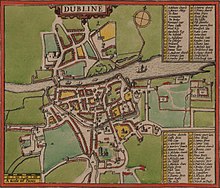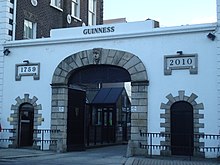St. James's Gate, located off the south quays of Dublin, on James's Street, was the western entrance to the city during the Middle Ages. During this time the gate was the traditional starting point for the Camino pilgrimage from Dublin to Santiago de Compostela in Galicia (Spain). Though the original medieval gate was demolished in 1734, the gate gave its name to the area in which it was located, and in particular to the St. James's Gate Brewery (which was taken over by Arthur Guinness in 1759).
Medieval city gate

As a walled city, the main entrances to Dublin were protected by city gates. St. James's Gate was the city's western entrance, and was named for the 12th century church and parish of St. James. Also named for St. James, a holy well in the area was the location of a longstanding summer festival.
Standing for up to 5 centuries, the gate was a toll point for goods entering the city. It is referenced in 13th-century texts, is marked on John Speed's 17th-century map of Dublin, and on Charles Brooking's early 18th-century map of the city. Dilapidated by time, the medieval gate was demolished by the mid 18th century.
Brewing in the area
See also: St. James's Gate Brewery
The St James's area has been associated with the brewing trade since the 17th century. A number of breweries had been established in Dublin up to the mid-17th century – one such brewery established by Alderman Giles Mee at St. James's gate around 1670. Giles Mee was given a lease to the water rights at St James's Gate (called "The Pipes") by Dublin Corporation. These rights passed to his son-in-law, Sir Mark Rainsford, a city alderman who was Mayor of Dublin between 1700 and 1701. Rainsford leveraged these water rights and, according to deeds from 1693, was producing "beer and fine ales" from St. James's Gate. There were also other brewers in and around St. James's Gate (owing to the water supply available in the area), and Rainsford's enterprise was not significantly different from the others. (Beer and ale were commodity products at the time as they were more commonly consumed than water – which contained contaminants that were removed in brewing.)
Sir Mark Rainsford died in 1709, and the lease passed to his son – also Mark Rainsford Esq. In 1715, the Rainsfords put the premises up for lease and it was taken by Captain Paul Espinasse. Espinasse reputedly had a role in the demolition of the original medieval gate - to ease access to the site and the city. Espinasse died in a fall from his horse near the Black Bull Inn at Drogheda in 1750.
For ten years the brewery site was on the market, and by 1759 the lease was in the hands of a third Mark Rainsford, the grandson of Sir Mark Rainsford. Arthur Guinness was interested in the premises, and on 31 December 1759, the lease was signed over to Guinness for 9,000 years at £45 per year. The site has been the location of the Guinness brewery ever since. Guinness has expanded well beyond the original 4-acre lot, and has consequently bought out the property, rendering the 9,000-year lease from 1759 redundant.
References
- "The Pilgrimage". Irish Society of the Friends of St.James. Archived from the original on 7 October 2011.
- ^ "Archive Fact Sheet: St. James's Gate" (PDF). guinness-storehouse.com. Archived from the original (PDF) on 15 November 2018.
The medieval gate of St. James was demolished in 1734, 25 years before Arthur Guinness took over the Brewery on the site
- ^ Stephen Mansfield (2009). The Search for God and Guinness: A Biography of the Beer that Changed the World. Nelson. ISBN 978-1-4185-8067-4.
Called St. James's Gate because of the church and parish by that name nearby, it stood for five centuries before crumbling to the ground. The name was retained for the location though, largely because there had been a holy well on the site that was the centrepiece for an annual summer festival
- ^ Bill Yenne (2007). Guinness: The 250 Year Quest for the Perfect Pint. John Wiley & Sons. ISBN 978-0-470-12052-1.
St. James's Gate was the ancient entrance to the city from the suburbs to the west. It took its name from the Church and Parish of St. James, which date back to the twelfth century. The gate is mentioned in the thirteenth century and shown both on Speed's 1610 map of Dublin and on Brooking's 1729 map of the city
- "Dublin City Archives - Record reference 'vital:5380' - WSC.Maps.563.face". libraries.dublincity.ie. Dublin City Archives. Archived from the original on 20 November 2018. Retrieved 19 November 2018.
Map of a parcel of ground, called "The Pipes", in the parish of St. James and County Dublin. Leased to Giles Mee in 1670, from the Cistern at James's Gate in 1670
- Adrian MacLoughlin (1979). Historic Dublin. Gill and Macmillan. p. 166.
- Desmond F. Moore (October 1960). "The Guinness Saga". Dublin Historical Record. 16 (2): 50–57. JSTOR 30082541.
- Guinness & Co Ltd (1928). Guide to St. James's Gate Brewery. Arthur Guinness, Son & Co Ltd. pp. 21–22.
When the first brewery was set up at St. James's Gate is not on record. In the year 1670 one Giles Mee, a brewer, obtained Sir Mark Rainsford, brewer, of St. James's Gate. Documents preserved in the Public Registry of Deeds, Dublin, record that in the year 1693 Alderman Sir Mark Rainsford had a brewhouse at St. James's Gate where "beer and fine ales" were made.
- Joseph Brady; Anngret Simms (2001). Dublin: through space and time (c. 900-1900). Four Courts. p. 80. ISBN 978-1-85182-641-4.
In 1734, when recommending the demolition of the building over St James' Gate Captain Paul Espinasse proposed that he pull down the gate and give a foot of ground on its south side to enlarge the passage, a proposal promptly accepted by the Corporation
- Guinness & Co Ltd (1952). Guinness, Dublin. Hely's Limited.
the St. James's Gate premises to Paul Espinasse, who carried on the brewing business there until 1750, when he was unfortunately killed by a fall from his horse at Drogheda
- "Sir Arthur Guinness". gallot.co.nz. Archived from the original on 18 September 2009. Retrieved 3 December 2009.
- "Guinness Storehouse FAQ". Guinness-Storehouse.com. Archived from the original on 11 July 2011. Retrieved 18 March 2012.
Q:I s the 9,000 year lease still valid? A: The 9,000 year lease signed in 1759 was for a 4 acre brewery site. Today, the brewery covers over 50 acres, which grew up over the past 200 years around the original 4 acre site. The 1759 lease is no longer valid as the Company purchased the lands outright many years ago
53°20′36″N 6°17′05″W / 53.343349°N 6.284617°W / 53.343349; -6.284617
Categories: